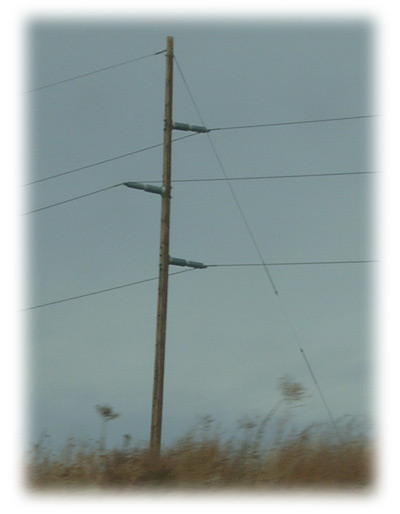
Power lines on poles are not insulated. If they were insulated they would overheat under high loads. Generally, they are composed of stranded aluminum wrapped around a steel reinforcing wire core. Only a few older wires are still copper. The wires that you see that are insulated are generally telephone wires, cable lines, and possibly the 120V lines to individual houses.
The individual power lines are called phases. The areas not carrying a current are called grounded. Grounded areas include the pole itself and any other components that are not electrified. Any time a bird (or person) is only touching one phase, they are safe. This is why a bird can stand on a single power line. No current flows through her in this case. When a bird touches two phases at once (phase-to-phase contact) or when a bird touches one phase and a grounded section (phase-to-ground contact) is when the circuit is shorted and the power travels through the bird. The bird may grab one power line in one foot then try to grab another line in another foot, she may be standing (safely) grabbing one line, but flap her wings and contact a grounded area, her tail may touch a grounded area, a transmitter may brush across a phase or ground, or she may be standing on a cross arm and stretch out her wings and contact two wires. The point of secondary contact can be another wire, the ground, a tree branch, or the cross arm.
 |
|
 |
A three phase power pole
|
 |
A three phase power pole with transformer boxes and jumper wires
|
 |
A transmission tower with long insulators
Although these look menacing, the long insulators ensure that a line cannot be grabbed while the raptor is grounded. These carry a huge amount of power, but electrocution from these is highly unlikely.
|
 |
On the center phase there is a long plastic component. This is a conducting insulator. The point is to prevent a bird from touching that center phase by covering it with this insulator.
Photo courtesy of Rick Harness and EDM International, Inc. |
 |
|
 |
Note the long horizontal insulators that keep the current away from grounded points. |
General guidelines
- Be careful if you are flying a large bird that tends to perch up high. Power poles will be very attractive to the bird. The distance between the phases may not be enough to prevent electrocution, especially for large birds.
- If there is a conducting insulator, it's still not perfectly safe, but it is there to make the phase safer. Instead of moving the phases apart, one or more phase may have a conducting insulator installed to prevent a raptor from touching two phases at once. This is no guarantee of safety, though, as even the safety devices can fail.
- Be careful of bare jumper wires that are positioned above the cross arm instead of under it. Since the birds are more attracted to the higher perches, as long as the tallest substantial perch is safe, then the bird will likely fare the situation. If in doubt, call your bird down and take another perch.
- As a grounded area, steel power poles are far more dangerous than the older wood ones as they are more conducive. Many birds have been in contact with one wire and the wood pole or cross arm and, although injured, they were not killed. The bird is far less likely to survive a phase-to-ground contact in the case of a steel pole and cross arm.
- Perch guards are sometimes installed to retrofit old power lines, but this is only to discourage roosting and a hunting raptor may not take notice. Elevated perches are also being installed above the cross arm with the intent that the birds are going to nest anyways, giving them a safe place to nest protects them and the power poles.
- Weather does play a bit of a role. Extra moisture or precipitation will wet feathers making them better conductors. Wind and weather might drive otherwise soaring birds to instead take a high perch and therefore increase their probability to be electrocuted.
- The US Fish and Wildlife Service does have a policy to have all of its power poles "bird friendly" so many of the poles on land managed by this service will be safe, but that is no guarantee.
If a bird is electrocuted, or you come upon a wild raptor that has been electrocuted, take the time to report it to the proper authorities. You will need to identify the nearest pole to the electrocuted raptor, preferably both by the pole's identification number (usually located on a small metal tag about eye level), but also relative to local landmarks such as street addresses or cross streets. If possible, take photographs of the raptor and the pole. Written reports should be submitted to US Fish and Wildlife as well as the utility company. Include as many specifics as you can regarding the species and the incident, photographs, and any other notes you can provide.
This page is also available in Russian: http://www.mybirds.ru/groups/lovch/electrocution.php
I'd like to thank Rick Harness for helping to make sure this content is accurate and supplementing the images. Rick is a wildlife biologist and expert on raptor electrocutions. He recently helped produce a video with NAFA on raptor electrocutions, Raptors at Risk.
For more information Rick also has a Hawk Chalk article on electrocutions: Harness, R.E. and K. Wilson. 1998. Review of falconers' electrocution data. Hawk Chalk 37:79-81.